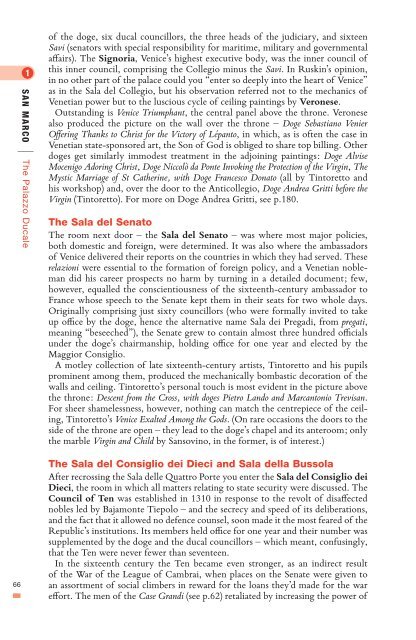You also want an ePaper? Increase the reach of your titles
YUMPU automatically turns print PDFs into web optimized ePapers that Google loves.
san marco<br />
|<br />
66<br />
<strong>The</strong> Palazzo Ducale<br />
of <strong>the</strong> doge, six ducal councillors, <strong>the</strong> three heads of <strong>the</strong> judiciary, <strong>and</strong> sixteen<br />
Savi (sena<strong>to</strong>rs with special responsibility for maritime, military <strong>and</strong> governmental<br />
affairs). <strong>The</strong> Signoria, <strong>Venice</strong>’s highest executive body, was <strong>the</strong> inner council of<br />
this inner council, comprising <strong>the</strong> Collegio minus <strong>the</strong> Savi. In Ruskin’s opinion,<br />
in no o<strong>the</strong>r part of <strong>the</strong> palace could you “enter so deeply in<strong>to</strong> <strong>the</strong> heart of <strong>Venice</strong>”<br />
as in <strong>the</strong> Sala del Collegio, but his observation referred not <strong>to</strong> <strong>the</strong> mechanics of<br />
Venetian power but <strong>to</strong> <strong>the</strong> luscious cycle of ceiling paintings by Veronese.<br />
Outst<strong>and</strong>ing is <strong>Venice</strong> Triumphant, <strong>the</strong> central panel above <strong>the</strong> throne. Veronese<br />
also produced <strong>the</strong> picture on <strong>the</strong> wall over <strong>the</strong> throne – Doge Sebastiano Venier<br />
Offering Thanks <strong>to</strong> Christ for <strong>the</strong> Vic<strong>to</strong>ry of Lépan<strong>to</strong>, in which, as is often <strong>the</strong> case in<br />
Venetian state-sponsored art, <strong>the</strong> Son of God is obliged <strong>to</strong> share <strong>to</strong>p billing. O<strong>the</strong>r<br />
doges get similarly immodest treatment in <strong>the</strong> adjoining paintings: Doge Alvise<br />
Mocenigo Adoring Christ, Doge Niccolò da Ponte Invoking <strong>the</strong> Protection of <strong>the</strong> Virgin, <strong>The</strong><br />
Mystic Marriage of St Ca<strong>the</strong>rine, with Doge Francesco Dona<strong>to</strong> (all by Tin<strong>to</strong>ret<strong>to</strong> <strong>and</strong><br />
his workshop) <strong>and</strong>, over <strong>the</strong> door <strong>to</strong> <strong>the</strong> Anticollegio, Doge Andrea Gritti before <strong>the</strong><br />
Virgin (Tin<strong>to</strong>ret<strong>to</strong>). For more on Doge Andrea Gritti, see p.180.<br />
<strong>The</strong> Sala del Sena<strong>to</strong><br />
<strong>The</strong> room next door – <strong>the</strong> Sala del Sena<strong>to</strong> – was where most major policies,<br />
both domestic <strong>and</strong> foreign, were determined. It was also where <strong>the</strong> ambassadors<br />
of <strong>Venice</strong> delivered <strong>the</strong>ir reports on <strong>the</strong> countries in which <strong>the</strong>y had served. <strong>The</strong>se<br />
relazioni were essential <strong>to</strong> <strong>the</strong> formation of foreign policy, <strong>and</strong> a Venetian nobleman<br />
did his career prospects no harm by turning in a detailed document; few,<br />
however, equalled <strong>the</strong> conscientiousness of <strong>the</strong> sixteenth-century ambassador <strong>to</strong><br />
France whose speech <strong>to</strong> <strong>the</strong> Senate kept <strong>the</strong>m in <strong>the</strong>ir seats for two whole days.<br />
Originally comprising just sixty councillors (who were formally invited <strong>to</strong> take<br />
up office by <strong>the</strong> doge, hence <strong>the</strong> alternative name Sala dei Pregadi, from pregati,<br />
meaning “beseeched”), <strong>the</strong> Senate grew <strong>to</strong> contain almost three hundred officials<br />
under <strong>the</strong> doge’s chairmanship, holding office for one year <strong>and</strong> elected by <strong>the</strong><br />
Maggior Consiglio.<br />
A motley collection of late sixteenth-century artists, Tin<strong>to</strong>ret<strong>to</strong> <strong>and</strong> his pupils<br />
prominent among <strong>the</strong>m, produced <strong>the</strong> mechanically bombastic decoration of <strong>the</strong><br />
walls <strong>and</strong> ceiling. Tin<strong>to</strong>ret<strong>to</strong>’s personal <strong>to</strong>uch is most evident in <strong>the</strong> picture above<br />
<strong>the</strong> throne: Descent from <strong>the</strong> Cross, with doges Pietro L<strong>and</strong>o <strong>and</strong> Marcan<strong>to</strong>nio Trevisan.<br />
For sheer shamelessness, however, nothing can match <strong>the</strong> centrepiece of <strong>the</strong> ceiling,<br />
Tin<strong>to</strong>ret<strong>to</strong>’s <strong>Venice</strong> Exalted Among <strong>the</strong> Gods. (On rare occasions <strong>the</strong> doors <strong>to</strong> <strong>the</strong><br />
side of <strong>the</strong> throne are open – <strong>the</strong>y lead <strong>to</strong> <strong>the</strong> doge’s chapel <strong>and</strong> its anteroom; only<br />
<strong>the</strong> marble Virgin <strong>and</strong> Child by Sansovino, in <strong>the</strong> former, is of interest.)<br />
<strong>The</strong> Sala del Consiglio dei Dieci <strong>and</strong> Sala della Bussola<br />
After recrossing <strong>the</strong> Sala delle Quattro Porte you enter <strong>the</strong> Sala del Consiglio dei<br />
Dieci, <strong>the</strong> room in which all matters relating <strong>to</strong> state security were discussed. <strong>The</strong><br />
Council of Ten was established in 1310 in response <strong>to</strong> <strong>the</strong> revolt of disaffected<br />
nobles led by Bajamonte Tiepolo – <strong>and</strong> <strong>the</strong> secrecy <strong>and</strong> speed of its deliberations,<br />
<strong>and</strong> <strong>the</strong> fact that it allowed no defence counsel, soon made it <strong>the</strong> most feared of <strong>the</strong><br />
Republic’s institutions. Its members held office for one year <strong>and</strong> <strong>the</strong>ir number was<br />
supplemented by <strong>the</strong> doge <strong>and</strong> <strong>the</strong> ducal councillors – which meant, confusingly,<br />
that <strong>the</strong> Ten were never fewer than seventeen.<br />
In <strong>the</strong> sixteenth century <strong>the</strong> Ten became even stronger, as an indirect result<br />
of <strong>the</strong> War of <strong>the</strong> League of Cambrai, when places on <strong>the</strong> Senate were given <strong>to</strong><br />
an assortment of social climbers in reward for <strong>the</strong> loans <strong>the</strong>y’d made for <strong>the</strong> war<br />
effort. <strong>The</strong> men of <strong>the</strong> Case Gr<strong>and</strong>i (see p.62) retaliated by increasing <strong>the</strong> power of







